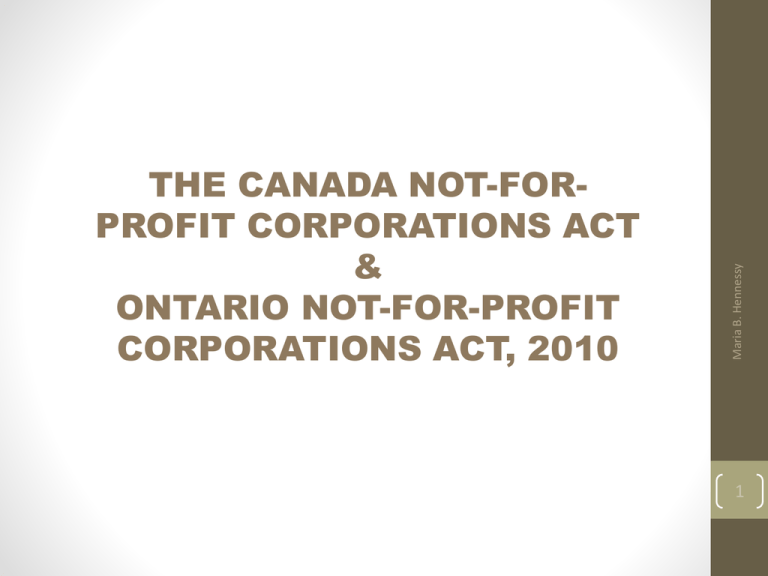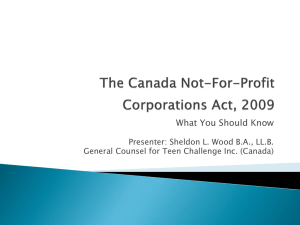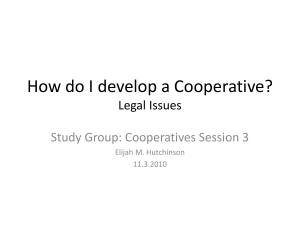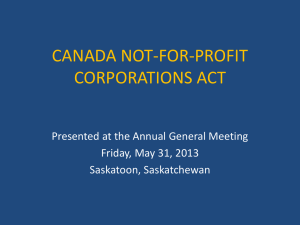the Powerpoint presentation
advertisement

Maria B. Hennessy THE CANADA NOT-FORPROFIT CORPORATIONS ACT & ONTARIO NOT-FOR-PROFIT CORPORATIONS ACT, 2010 1 THE CANADA NOT-FOR-PROFIT CORPORATIONS ACT All federal corporations incorporated under the old legislation must transition to the CNCA by October 17, 2014. The “old legislation” - (CCA, Part II) - will continue to apply to the federal existing corporations until they make the transition. http://laws-lois.justice.gc.ca/eng/acts/C1.8/index.html The corporations are required to complete a continuance process by October 17, 2014 otherwise they will be dissolved. Maria B. Hennessy The CNCA was enacted in June 23, 2009. It came into force on October 17 2011. http://lawslois.justice.gc.ca/eng/acts/C-7.75/ 2 SOME HIGHLIGHTS OF THE CNCA More simplified processes. The corporations may carry on activities throughout Canada, and outside Canada to the extent that the laws of that jurisdiction permit. Financial gain to their members only as part of the development of the corporations’ activities or it is permitted by the Act. Maria B. Hennessy More flexibility for fundamental changes, i.e. amalgamation. At special meetings, members may remove a director by majority vote. Ex-officio directors are not permitted. 3 SOME HIGHLIGHTS OF THE CNCA CONT. In principle the responsibility of managing and supervising the management of a corporation rests with the board of directors. A corporation is soliciting when it has received more than $10,000.00 in income from public sources. Every corporation must have at least one director, but a soliciting corporation must have no fewer than three directors (at least two of them, should not be officers or employees of the corporation or its affiliates). The corporations must have members and the articles must set out the classes of members. Maria B. Hennessy Annual meetings of members should be held - written resolutions instead of a meeting are allowed. 4 SOME HIGHLIGHTS OF THE CNCA CONT. If the corporation has only one class of members, all members are eligible to vote. The members can request a meeting of members with 5% of those with voting right. Any member can submit proposals to amend the by-laws or require any matter to be discussed at annual meetings. Maria B. Hennessy If the corporation has two or more classes of members, the articles must assign voting right to at least one class of members. Members can submit proposals to nominate directors of the board, with 5% of those with voting right. Members can have access to corporate records, including membership list. 5 SOME HIGHLIGHTS OF THE CNCA CONT. In corporations that have multiple membership classes or groups, all members are entitled to vote as a separate class or group on certain amendments to the articles or bylaws and fundamental changes. So, each class or group of members (including non-voting members) will have de facto veto right. Members of a corporation must appoint a public accountant at their annual meeting, except: a) if the soliciting corporation has a gross annual revenue equal to or less than $50,000.00, and b) if the non-soliciting corporation has a gross annual revenue equal to or less than $1million. Maria B. Hennessy Except for soliciting corporations, unanimous member agreement is available to restrict, in whole or in part, the powers of the director to manage or supervise the management of the corporation on its activities and affairs. 6 TYPES OF FINANCIAL REVIEW TYPE OF CORPORATION GROSS ANNUAL REVENUE CNCA MEMBERS’ OPTIONS FINANCIAL REVIEW SOLICITING Equal or Review engagement Audit * SOLICITING Between $50,000 & $250,000 Audit Review engagement SOLICITING More than $250,000 Audit NIL NON-SOLICITING Equal or less than $1 million Review engagement Audit * NON-SOLICITING More than $1 Million Audit NIL Maria B. Hennessy less than $50,000 7 TRANSITION PROCESS The articles of continuance should be approved by special resolution of members of the corporations and signed by a member of the board of directors or officer of the corporations, who is making the transition into the CNCA. Afterward, the articles must be submitted to Corporation Canada, which will issue a Continuance Certificate. The corporations do not have to file the by-laws to obtain the Continuance Certificate. Maria B. Hennessy Obtain Certificate of Continuance and making by-laws in compliance with the CNCA. There is no fee to obtain the Certificate of Continuance or to file by-laws for the existing federally incorporate not-for-profit corporations. 8 TRANSITION PROCESS CONT. a. b. c. d. e. Industry Canada produced a Transition Guide that contains: Provisions in letters patent and by-laws replaced by the CNCA Instructions for completing articles of continuance Mandatory and default rules Checklist for continuance/transition documents Examples of articles of continuance with one class and two classes of members, as well as examples of by-laws, and special resolutions. http://www.ic.gc.ca/eic/site/cddgc.nsf/eng/h_cs04954.html Maria B. Hennessy During the transition period, it is advisable for federal corporations that are or aim to become registered charities under the Income Tax Act to consult the Charities Directorate of the Canada Revenue Agency (CRA). 9 TRANSITION PROCESS Corporation Canada prepared for the corporations a page highlighting the most common deficiencies in filling out the articles of continuance and how to avoid the errors http://www.ic.gc.ca/eic/site/cddgc.nsf/eng/cs05430.html Corporation Canada developed an online interactive tool “By-law Builder,” http://www.ic.gc.ca/eic/site/cddgc.nsf/eng/h_cs04734.html Maria B. Hennessy CONT. 10 ONTARIO NOT-FOR-PROFIT CORPORATIONS ACT, 2010 Bill 85 in schedule 7 proposes amendments to the ONCA http://www.ontla.on.ca/web/bills/bills_detail.do?locale=en&I ntranet=&BillID=2812 ONCA is anticipated to come into force no earlier than six months after enactment of Bill 85. Maria B. Hennessy ONCA received Royal Assent on October 25, 2010 and replaced Part III of the Ontario Corporations Act (OCA). http://www.ontla.on.ca/web/bills/bills_detail.do?locale=en&I ntranet=&BillID=2347 Existing Ontario not-for-profit corporations will have a threeyear transition period. All provisions of the ONCA will apply to new Ontario not-forprofit corporations that incorporate under the ONCA. 11 It will apply to every corporation without share capital incorporated in Ontario under any Act of the Ontario Legislature, including Ontario Corporations Act (OCA), with the exception of : 1. Insurance corporations 2. Corporations without share capital under the Cooperative Act Corporations excepted by legal statutes, such as those incorporated by or under special or private Acts or other public Acts, i.e. agricultural societies, conservation societies, etc. 3. Share capital corporations with social nature. These corporations will continue under OCA for five years. After that period, they will continue as one of the three following types of corporations: a. A non-share capital corporation under ONCA, or b. A cooperative corporation under the Cooperative Corporations Act, or c. A share capital corporation under Ontario Business Corporations Act. Maria B. Hennessy THE ONCA 12 THE ONCA CONT. To transition from the old legislation (OCA), the corporations must follow the process prescribed by ONCA in order to obtain articles of amendment. ONCA contains three types of rules: a. mandatory rules i.e. minimum three directors, b. default rules i.e. directors can borrow money and grant security on property without members’ authorization, directors may meet anywhere, and c. alternate rules i.e. audit committee, holding members’ meeting entirely by electronic means. Where ONCA is silent, corporations can include provisions in their by-laws or policies that do not contravene ONCA and its regulations, i.e. corporations can include mechanisms to resolve disputes among members. Maria B. Hennessy There is no express obligation for the already incorporated Ontario not-forprofit corporations to make a transition. At the end of the three (3) years deadline, the documents of the corporations will be considered to be amended to bring them into agreement with the ONCA. 13 THE ONCA CONT. By-laws or application for certificate of amendment do not need to be filed with the Ontario government for incorporation; but they should be made and approved within sixty days of filing for incorporation or certificate of amendment. Corporations incorporated under ONCA that do not adopt organizational by-law within sixty days of their incorporation, will be considered to have adopted the default organizational by-law. The default organizational by-law does not apply to corporations incorporated under OCA, even if the corporations do not have any organizational by-law. Maria B. Hennessy All applications for articles of incorporation should be submitted to Service Ontario. 14 A modern legal framework to ensure that there will be more transparency and accountability in how the corporations are ran: a. Facilitates the process, i.e. corporations can incorporate electronically; b. Provides more clarity about boards of directors and members; and c. Simplifies the requirements for audits and financial review. There are two categories of corporations: Non-Public Benefit Corporations and Public Benefit Corporations, which are divided in: Charitable Corporation (incorporated for the relief of poverty, advancement of education, advancement of religion, or other charitable purpose) PBCs Non-Charitable Corporations (receive more than $10,000 during a fiscal year in gifts or donations from persons that are not members, directors, officers, or employees of the corporations; or receive grants or similar financial assistance from the federal, provincial, or municipal government or government agency) Maria B. Hennessy GENERAL HIGHLIGHTS OF THE ONCA 15 GENERAL HIGHLIGHTS OF THE ONCA CONT. There is no longer necessary to include in the articles of incorporation of a charitable corporation special provisions about the duties and obligations of the charity and its directors. Maria B. Hennessy The approval of the Office of the Public Guardian and Trustee (OPGT) is no longer required to incorporate as a charitable corporation. The OPGT will still need to pre-approve applications for articles of amendment, amalgamation and continuation. Application for change only of the name of the charitable corporation does not need the approval of the OPGT. 16 1. 2. 3. 4. New voting alternatives: proxies for members voting (mandatory), mailed-in-ballot, telephone voting, or electronic means voting. Not-for-profit corporations can engage in commercial activities to support their purposes. Maria B. Hennessy GENERAL HIGHLIGHTS OF THE ONCA CONT. Under ONCA the corporations do not need to pass a bylaw for borrowing powers. 17 GENERAL HIGHLIGHTS OF THE ONCA CONT. Charitable corporations to charitable corporation with similar purpose or to a government or government agency PBCs Non-charitable corporations to a PBC or to a government or government agency According to the corporation’s articles, or Maria B. Hennessy Upon liquidation and dissolution corporations must distribute their net assets as follow: Non-PBCs If no provisions in the articles then proportionately to the members 18 PROVISIONS REGARDING DIRECTORS Members by ordinary resolution may elect or remove directors with exception of ex-officio - The by-laws may stipulate rules governing ex-officio directors. Directors may be elected up to four years term. A person who is elected or appointed to become a director must consent before or within ten days after their election or appointment. If the consent is provided after ten days, it must be in writing. Maria B. Hennessy All the corporations must have a minimum of three directors. For the PBCs, no more than one-third of their directors may be employees of the corporations or the corporations’ associates. 19 To become a director, in addition to the qualifications included in the corporation’s by-laws, he or she must: a. be eighteen years of age or more, b. have not been found incapable under any court in Canada or elsewhere, or under the Substitute Decision Act of 1992 or the Metal Health Act, and c. have not declared bankrupt If a class or group members has the exclusive right to elect a director, only them, through an ordinary resolution may remove the director. Directors may appoint additional directors to hold office until the next annual members’ meeting, up to a maximum of one-third of the number of directors elected at the last annual members’ meeting. Maria B. Hennessy PROVISIONS REGARDING DIRECTORS CONT. 20 Directors and officers have the duty to look to the best interests of the corporation and to act honestly and in good faith. The directors are provided with a reasonable due defense, if they exercise the care, diligence and skills that a carefully and prudent person will exercise under similar circumstances. ONCA lists specific cases under which the director and officers must report conflict of interest, i.e. when a director sits on the board of two not-for-profit corporations that intend to enter in a contract with each other, a conflict of interest may occur. Maria B. Hennessy PROVISIONS REGARDING DIRECTORS CONT. Directors have the right to attend and be heard at the members’ meeting, but members do not have the right to attend the directors meeting. 21 PROVISIONS REGARDING OFFICERS & COMMITTIES The board of directors can set out committees to deal with issues that require special expertise. Members of the executive committee must also be members of the board of directors, and the audit committee must have a majority of members that are not officers or employees of the corporation. Maria B. Hennessy Directors may be appointed as officers of the corporation. The board of directors may grant authority to a committee or a managing director to take decisions that make the corporation legally responsible. 22 PROVISIONS REGARDING MEMBERS Gives more powers to members, similar to the powers of shareholders. All the members of a corporation with only one class or group of members have the right to vote at the meeting of members. In corporations with multiple classes or groups of members, at least one class or group of members, must have the right to vote. Voting and non-voting class members are entitled to vote separately as a class, to approve by special resolution, changes that affect their class of membership or important related changes. So, each class member could reject the change by using a de facto class veto right. Maria B. Hennessy Unless the articles indicate something different, each member has the right of one vote at the meeting of members. 23 PROVISIONS REGARDING MEMBERS CONT. The conditions for membership must be set out in the corporations’ by-laws. In certain circumstances a member’s proposal does not need to be included in meeting notices, i.e. personal matters against the corporation or when the proposal is not substantially related with the activities of the corporation. Members have some remedies if they believe directors are not acting on the best interest of the corporation, i.e. members can request the court to order directors and officers to comply with the Act, articles, or by-laws. Maria B. Hennessy Only voting members can make proposals, or request a meeting of members, but they need to have ten percent of the votes that they may cast at the meeting of members. 24 Members have the right to see the financial records at the annual meeting; they can request to receive them no less than twenty one days before the meeting. By default, membership may only be transferred to the corporation. Maria B. Hennessy PROVISIONS REGARDING MEMBERS CONT. The examination of members’ register is limited to a member, his/her attorney or legal representative, corporation’s creditors and a director of the corporation. 25 PROVISIONS REGARDING MEMBERS CONT. It is required that the disciplinary action or termination of membership be done in “good faith and in a fair and reasonable manner.” The process is considered “fair and reasonable” if the member is provided with a fifteen day notice, including the reasons for the disciplinary action or termination, and the member is given an opportunity to contest those reasons. Maria B. Hennessy There are default rules about termination of membership and members’ rights. 26 Maria B. Hennessy TYPES OF FINANCIAL REVIEW 27 AMENDMENTS TO THE ONCA Non-charitable corporations that receive more than $10,000 during its fiscal year from specific public sources will become PBCs. Bill 85 proposed that such amount may be set by regulation to facilitate adjusting the amount periodically, without the need to amend ONCA. The person appointed or elected to be a director must always express his/her consent in writing and corporations must keep the consent of directors “in the approved form”. Bill 85 proposed mandatory transition process, and the ONCA’s mandatory provisions must be added to the articles of the corporations during the transition period. Otherwise, the articles will be considered invalid when the transition period expires. Maria B. Hennessy They are mainly administrative and technical in nature. 28 AMENDMENTS TO THE ONCA CONT. Bill 85 proposed to delay the voting right of non-voting members for at least three years after ONCA comes into effect. The practicality of this proposed amendment is that corporations can adopt certain articles of amendment or certain new by-laws during the transition period, without seeking class approval of their non-voting members. However, the class approval by voting members remains in effect as the right of voting members to class vote has not been postponed. The Bill clarifies that the rights of creditors and others at the moment of incorporation remain valid after continuance. Maria B. Hennessy Bill 85 proposed that all amendments to articles, by-laws, or special resolutions must be done all at once during the transition period and not incrementally. 29 Gather all the corporation documents: letters patent, supplementary letters patent, by-laws and special resolutions. If the letters patent and supplementary letters patent are not located, the corporation can contact the Ontario Ministry of Government Services to request copies. www.mgs.gov.on.ca. Also if the corporation is registered charity the Charities Directorate may have some of these documents. http://www.cra-arc.gc.ca/charities/ Determine how much time the corporation needs for the transition, keeping into consideration, the time needed for the revision of the by-laws and other governance documents, the complexity of the changes required, and the consultation process with members, particularly, if the corporation has chapters and divisions across the province or country. Assign the responsibility for the process to somebody and engage the board since the first stages. Maria B. Hennessy CONSIDERATIONS FOR THE TRANSITION 30 CONSIDERATIONS FOR THE TRANSITION CONT. Review the corporation’s purposes in the letters patent and supplementary letters patent, to be sure they are consistent with the current and future activities of the corporation. If not, perhaps this could be a good opportunity to update the corporation’s purposes. Determine if the corporation’s structure and practice are in need of a change. Maria B. Hennessy Look for appropriate advice (legal, financial, etc.) on how ONCA will apply or affect the corporation in particular. Evaluate what kind of challenges present some of the ONCA’s provisions to the corporation, i. e. the right of the members to submit proposals, etc. Review mandatory provisions such as number of directors, membership structure. Keep in mind that under ONCA membership classes must be set out in the articles of the corporation. 31 CONSIDERATIONS FOR THE TRANSITION CONT. Prepare an update list of the members. Under ONCA the conditions for membership must be set out in the by-laws. Under ONCA corporations do not need to have a by-law for borrowing powers; therefore the corporation should review their provisions for borrowing powers to determine if they should be changed or removed. Maria B. Hennessy Review the corporations’ by-laws regarding directors and officers provisions, such as terms in office, conflict of interest, insurance stipulation, etc. Check the provision regarding voting methods to comply with the new requirements of mandatory proxies and alternatives means of voting. Decide if the corporation needs to make a provision specifying different rules for transferability of membership. Otherwise the membership can only be transferred back to the corporations. 32 CONSIDERATIONS FOR THE TRANSITION CONT. Find out if the corporation should update the corporate name registration, or if the corporation should provide the transition documents to the Charities Directorate of Canada Revenue Agency (CRA) or its umbrella organization. Maria B. Hennessy Review of all other by-laws to be sure that they are in accordance with the requirements of ONCA. Update accordingly the corporation’s policies, manuals, etc. and train staff and volunteers about the new governance documents. Check for updates. 33 AVAILABLE TOOLS A draft default by-law about organizational matters http://www.sse.gov.on.ca/mcs/en/Pages/onca6.aspx A transition check list that can be used as a reference tool to ensure compliance with ONCA. http://www.sse.gov.on.ca/mcs/en/Pages/onca4.aspx Maria B. Hennessy The Ministry of Consumer Services has prepared the following tools: A guide written in a plain language with the sections of ONCA that may have a major impact on corporations. http://www.sse.gov.on.ca/mcs/en/Pages/onca7.aspx Key terms within the ONCA. http://www.sse.gov.on.ca/mcs/en/Pages/onca2.aspx A toolkit that includes presentation slides, speaker points, presenter questions and answers, newsletter, bulletins, web text and Facebook posts. The toolkit can be requested by email at ONCAtools@ontario.ca. 34 SOME SIMILAR PROVISIONS UNDER CNCA & ONCA The Acts eliminated the Ultra Vires concept, which means that the acts of corporations outside their purposes are considered valid. Under both Acts, incorporated corporations have the capacity, rights, powers and privileges of a natural person. Maria B. Hennessy The letters patent used for the creation and/or reorganization of the corporations are replaced by articles in which the corporations will set out their purposes. 35 Changes To The Non-Profit Legislation: The Canada Not-For-Profit Corporations Act & Ontario Not-For-Profit Corporations Act, 2010 http://www.spcottawa.on.ca/sites/all/files/Chang es%20in%20NFP%20Legislation%20-FINAL%20Dec%202013.pdf Maria B. Hennessy ADDITIONAL SOURCES OF INFORMATION ONCA resources from government, nonprofits and law firms http://nonprofitlaw.cleo.on.ca/learn-more/ 36 This PowerPoint presentation is for general information purposes with the understanding that under no circumstance its contents represent legal advice. Viewers are advised to consult with a lawyer or other appropriate advisor concerning the specifics of their particular situation. Maria B. Hennessy DISCLAIMER 37









